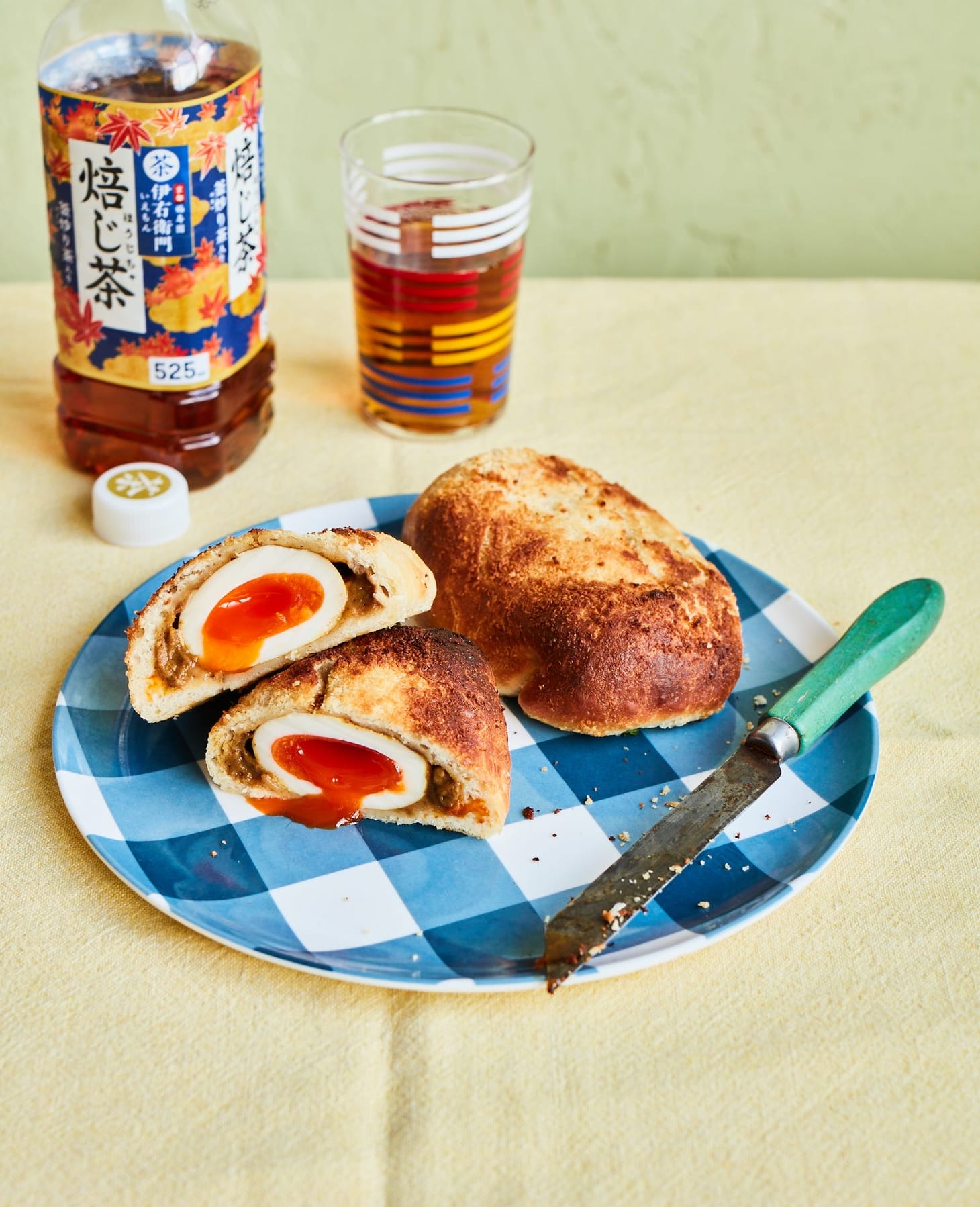Book Excerpt: Gooey Egg Curry Breads
From Tim Anderson's 'JapanEasy Bowls & Bento'

Table of Contents
You can find all three recipes (plus a few extras from the end matter) in the PDF:

Japaneasy Gooey Egg Curry Bread5.58MB ∙ PDF fileDownloadDownload
BASIC JAPANESE BREAD ROLL DOUGH
MAKES 12 SMALL SWEET BUNS OR 8 LARGER SAVORY BUNS
Besides shokupan, perhaps the most versatile type of Japanese bread dough is a simple, lightly sweetened white dough which is used for the sweet and savoury rolls that are staples of bakeries, supermarkets and convenience stores. These include sweet red bean buns, hot dog rolls and baked curry bread (recipes follow), as well as custard buns, chocolate cornets, buns filled with whipped cream and jam, and a variety of sōzai pan, or savoury side dish buns, that feature Japanese comfort foods like tuna mayo, croquettes or yakisoba in a convenient hand-held bread-based format. The bread is also very nice on its own, soft, pillowy and mildly sweet, so you can just have it with soup or a salad for a light meal. You will need a stand mixer with a dough hook for this recipe.
INGREDIENTS:
7 g (¼ oz) yeast
160 ml (5 ½ fl oz / ⅔ cup) lukewarm water
360 g (12 ⅔ oz) very strong bread flour
15 g (½ oz) golden caster (superfine) sugar
5 g (¼ oz) salt
1 tablespoon milk
1 egg
1 tablespoon honey
20 g (¾ oz) margarine or butter, plus more for greasing
PREPARATION:
Mix the yeast and water in a measuring jug until dissolved. Combine the flour, sugar and salt in a stand mixer fitted with a dough hook. Add the milk and egg to the yeasted water, then pour this into the stand mixer while mixing on low speed, then add the honey. When the dough comes together, add the margarine in small pieces and turn the speed up to medium. Knead for about 10 minutes, or until the dough passes the ‘window pane’ gluten test (see shokupan method, opposite). Place the dough in a lightly buttered bowl, cover loosely with cling film (plastic wrap) or a tea towel (dishcloth), and leave to prove somewhere warm for about an hour, or until doubled in size. Proceed to shape and bake according to the recipes that follow or, to make plain rolls, simply divide the dough into 12 equal pieces (50 g / 2 oz each). Place on paper-lined trays, and leave to rise again for 45 minutes–1 hour before baking in a fan oven at 200C (400F / gas 6) for 10 minutes.
GOOEY EGG CURRY BREAD
MAKES 8 BUNS
For almost as long as they have been eating curry and bread in Japan, they have been eating bread filled with curry. Curry bread, or karē pan in Japanese, was invented in or around the 1920s, and remains a firm favourite, sold not only at bakeries and convenience stores but also dedicated curry restaurants, who often offer house-made curry pan as a takeaway item, sort of like a souvenir. Typically, curry pan is deep-fried, like a doughnut. But it works very well baked, too, which is what this recipe is for.
INGREDIENTS:
40 g (1½ oz) Japanese curry roux
200 ml (7 fl oz / scant 1 cup) water
1 batch of Basic Japanese Bread Roll Dough, page 185 [in the book]
plain (all-purpose) flour, for dusting
8 eggs, soft-boiled and peeled (for timings, see Marinated Eggs, page 101 [or below])
1 egg, beaten well with a splash of milk
10–15 g (½ oz) panko
PREPARATION:
Reconstitute the curry with the water. You can either do this in a saucepan or the microwave – for the latter, simply heat the roux and the water together in 30-second bursts, stirring in between each cook until completely dissolved and thickened – this should take about 2–3 minutes in total. Leave the curry in the refrigerator to cool completely while you prepare the rest of the recipe.
After the first rise of the dough, divide it into 8 equal (75 g/2½ oz) balls on a lightly floured surface. With a rolling pin, flatten each ball out into a circle about 15 cm (6 in) in diameter; make the outer edges of the circle thinner than the centre. If the centre of the dough is stretched too thin, the buns could rupture while baking. Place a big spoonful of the chilled curry sauce in the middle of each dough circle, and place an egg on top of the curry. Draw up two dough edges on either side of the buns and pinch them together at the top of the egg. Draw up the other two edges, pinching them together on top of the other dough seam to completely enclose the egg and curry. Place the sealed buns, seam-side down, on baking parchment-lined baking sheets about 5 cm (2 in) apart, and leave to prove again for about 15 minutes.
Preheat a fan oven to 200C (400F / gas 6). Brush the rolls with the beaten egg and sprinkle each one with a large pinch of panko. Bake for 15 minutes, and leave to cool slightly before eating. You can also serve these at room temperature and they will last for a day in the refrigerator.
MARINATED EGGS
MAKES 6
The quintessential ramen topping ajitsuke tamago, literally ‘seasoned eggs’, also makes excellent breakfast and bento fodder (not to mention a fabulous garnish for all sorts of other dishes). This recipe uses tsuyu as the pickling medium, which imparts the egg with moreish umami and a delicate smokiness without making it too salty. Store-bought tsuyu is good and very convenient, but also pretty expensive; you can make your own using the recipe on page 206 [or the pdf]. The addition of aromatic ingredients is partially inspired by Korean mayak eggs, which have recently become trendy in Japan.
INGREDIENTS:
6 large eggs, at room temperature
200 ml (7 fl oz / scant 1 cup) tsuyu
1 spring onion (scallion), finely sliced and rinsed under cold water
1 garlic clove, grated
1 cm (½ in) fresh ginger root, peeled and shredded
1 teaspoon sesame seeds
½ teaspoon vinegar
½ teaspoon sesame oil
PREPARATION:
Fill a large saucepan with water and bring it to a rolling boil, then lower in the eggs. Boil them for 6 minutes and 20 seconds, or 6 minutes and 40 seconds if you want the yolks more fudgy rather than gooey; cook for a full 7 minutes if you want your yolks quite firm (if you keep your eggs in the refrigerator, add 30 seconds to all of these timings). When the timer’s up, remove the eggs with a slotted spoon, then chill them quickly in cold water. Stir together all the other ingredients. When they’re completely cool, peel the eggs and soak them in the tsuyu mixture, in the refrigerator, for 4–24 hours. If you like, you can serve these with some of the marinade, as well as the spring onions and sesame spooned on top. Serve these cold or at room temperature. They last six days in the refrigerator.

Excerpted with permission from JapanEasy Bowls & Bento by Tim Anderson published by Hardie Grant Books, October 2022, RRP $35.00 Hardcover.
wordloaf Newsletter
Join the newsletter to receive the latest updates in your inbox.




